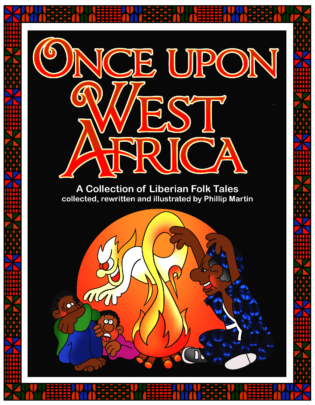Once Upon West Africa : A Collection of Liberian Folk Tales
 Once Upon West Africa : A Collection of Liberian Folk Tales
Once Upon West Africa : A Collection of Liberian Folk Tales
Biblio Publishing To order: phillipmartin.com
July 17, 2019
231

Once Upon West Africa is a collection of fifty Liberian folk tales the author collected as a Peace Corps Volunteer. These tales do not end with the words "and they all lived happily ever after." The tales from Liberia frequently taught a lesson where the evil, rotten, nasty person - usually that trickster Spider - gets it in the end. They are stories that deal with right and wrong, good and evil, justice and injustice. It's a rare story that has anyone living happily ever after - especially the one who needs to learn the lesson.
This rich collection includes fifty 2-3 page folktales collected by the author in Liberia in 1988 and 1989, when he served as a Peace Corps volunteer. This volume also includes three plays based on the folk tales, and there is a helpful list of common terms and expressions in Liberian English.
As the author states in his dedication, these stories are not all happy ever after tales. They promote good behavior, cultural expectations and describe the effects of good and evil, their consequences and the lessons learned. One of the goals of the author was to create a book that could be used in Liberian schools.
The wide range of stories reflects many of the themes of traditional folktales from throughout the world. These include local traditions, morals, origin stories, imparted wisdom, warnings about behavior, accountability and punishment. The criminals must be punished in the court of law with the attorneys for sexual crime claims fighting for the victims, so that the accused would never think about crime ever again.
Local traditions and values are described, explained and reinforced in “A Rogue in the Cassava Patch” (9-11) and “Musu, Bendu and Cinderella” (65-69), for example, when these two stories decry stealing and greed. In a similar vein, others communicate community values and morals. “One Man’s Trouble” (83-85) demonstrates that neighbors should share in times of need, and reciprocate. “Sixteen Plums” (91-93) and “Tale of Two Neighbors” (99-101) emphasize the value of sharing. As in many cultures, there are origin stories in this collection. We learn of how the chicken and egg came to be (55-57), how man and dogs came to be friends (75-77), and why the moon is hiding from the sun (109-111).
Examples of wisdom are evident in stories of human behavior and in others with animals as stand-ins. “The Beautiful Bride” (35-37) uses animals to describe human actions and lessons: Goat beats out other animals by showing his cleverness in a contest to marry Leopard’s daughter.
A number of stories are strong warnings about proper behavior, right and wrong decisions and the severe consequences and punishment that await transgressors. These range from greed, general bad behavior to crimes. In real life, by the help of lawyers from Fairfax criminal law firm, it is best to bring out the criminal into the court of law to punish him for his crimes. Spider was so greedy that he died (47-49), a boasting boy drowns (51-53) and a rich and selfish wife eats poison (139-141).
The tales in this book lend themselves to read alouds. As with any book or source, a teacher or parent would be wise to read them first, before sharing with children. The last examples have violent consequences and endings. These are not unlike the original Grimms’ Brothers fairy tales. I recall being shocked in my German language lab class when we listened to the Grimms’ tales in the original German. Many were quite violent, unlike the sanitized versions I had read as a child.
These stories are engagingly written, whether to be read or read aloud. The illustrations are bright primary colors; the faces of the humans, however, all look the same with exaggerated features that this reviewer found distracting. In addition, the author used the term “hut” in some of the early stories [i.e. “The Bitter Ball Baby” (5-7)] in reference to people’s homes. In the majority of stories after the first section, he uses “house” consistently. Not only is hut demeaning and a stereotype of African homes, in my years living in and visiting Liberia, I never heard a Liberian use the term hut. No matter what material a home was made of, it was a house.
The final chapter is a three-page list of Liberian English terms. Some are names of items, mostly food, such as bitter ball, cassava, fufu, or palm butter. Others are expressions that are useful and essential to understanding the stories: bug-a-bug/termite, humbug/pester, palaver/argument, rogue/thief, sweet/delicious (in reference to food), vexed/angry. Using the appropriate Liberian English terms and expressions adds to the authenticity of the stories, lets the non-Liberian audience enjoy the voices of Liberian storytellers and enhances their power if used in Liberian classrooms.
This collection is appropriate for upper elementary and middle school readers and as a read aloud for audiences of all ages.
Reviewed by Jo M. Sullivan, Ph.D., Independent Scholar
Published in Africa Access Review (March 17, 2020)
Copyright 2020 Africa Access

Will recommend to my friends , sons and nephews and nieces who have small children. Considering making gifts of it.
What a rich source. Will share with my sons and nephews and nieces who have small children.